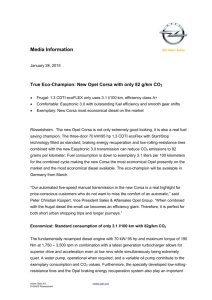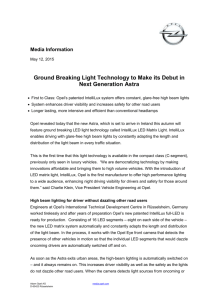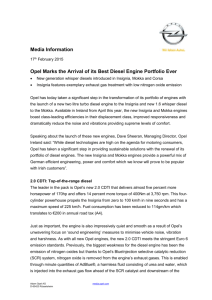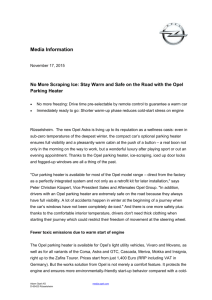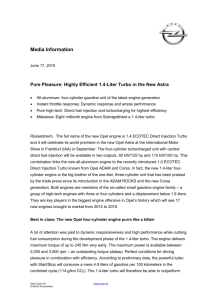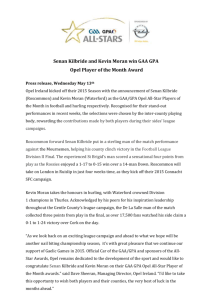Opel Media Information - GM Media
advertisement
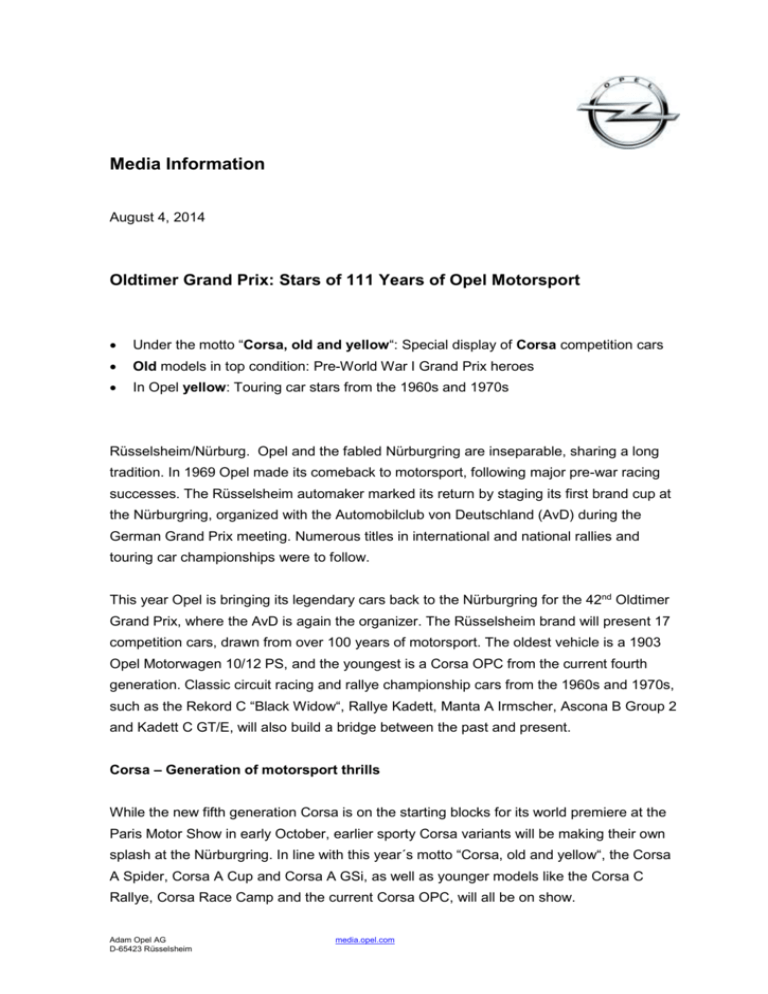
Media Information August 4, 2014 Oldtimer Grand Prix: Stars of 111 Years of Opel Motorsport Under the motto “Corsa, old and yellow“: Special display of Corsa competition cars Old models in top condition: Pre-World War I Grand Prix heroes In Opel yellow: Touring car stars from the 1960s and 1970s Rüsselsheim/Nürburg. Opel and the fabled Nürburgring are inseparable, sharing a long tradition. In 1969 Opel made its comeback to motorsport, following major pre-war racing successes. The Rüsselsheim automaker marked its return by staging its first brand cup at the Nürburgring, organized with the Automobilclub von Deutschland (AvD) during the German Grand Prix meeting. Numerous titles in international and national rallies and touring car championships were to follow. This year Opel is bringing its legendary cars back to the Nürburgring for the 42nd Oldtimer Grand Prix, where the AvD is again the organizer. The Rüsselsheim brand will present 17 competition cars, drawn from over 100 years of motorsport. The oldest vehicle is a 1903 Opel Motorwagen 10/12 PS, and the youngest is a Corsa OPC from the current fourth generation. Classic circuit racing and rallye championship cars from the 1960s and 1970s, such as the Rekord C “Black Widow“, Rallye Kadett, Manta A Irmscher, Ascona B Group 2 and Kadett C GT/E, will also build a bridge between the past and present. Corsa – Generation of motorsport thrills While the new fifth generation Corsa is on the starting blocks for its world premiere at the Paris Motor Show in early October, earlier sporty Corsa variants will be making their own splash at the Nürburgring. In line with this year´s motto “Corsa, old and yellow“, the Corsa A Spider, Corsa A Cup and Corsa A GSi, as well as younger models like the Corsa C Rallye, Corsa Race Camp and the current Corsa OPC, will all be on show. Adam Opel AG D-65423 Rüsselsheim media.opel.com Page 2 The front-wheel drive, 1982 Corsa A will be accompanied by a spectacular concept. Even before the new compact model was unveiled in the summer of 1982, the Corsa Spider ignited the spark for a sporty version of the model. The four-seat, open Corsa Spider can be transformed into a two-seater or even a monoposto with the help of glass-fiber reinforced plastic body parts. The Spider is equipped with a head restraint in the style of a racing car from the 1950s. However, with its prominent fenders, full-width lights behind a smoked glass panel and pearlescent-white paint finish, the Spider is a typical child of its times. The Corsa Cup model made its debut in 1983. The Kadett D and Corsa A actually competed against each other in the ONS Opel Junior Cup, the successor to the Kadett Cup introduced in 1979 for amateur and young racing talent. The Kadett 1.3 had 75 hp, while the Corsa Cup delivered 70 hp. The first races and rallye events were held in 1985, with prize monies totaling 100,000 German marks. The Junior Cup winner received a Corsa 1.3 S at the end of the year. In 1988, a new top-of-the-line Corsa model was introduced: the Corsa A GSi featured a 1.6-liter engine with 101 hp and had a top speed of 186 km/h. It remained in the Corsa line-up until 1992, when the Corsa B generation hit the market. The Corsa C was introduced in 2000, and the Corsa Super 1600 variant made its debut at the Essen Motor Show the same year. This new rallye Corsa was powered by a 1.6-liter, 16V four-cylinder engine with 200 hp and, like its predecessors, was designed to provide affordable motorsport on asphalt and gravel tracks. The current fourth generation Corsa OPC has been available since 2007. With a turbocharged, 1.6-liter four-cylinder engine, the sportiest and most extreme Corsa D variant delivers 192 hp. At the Nürburgring in the Opel tent as Corsa OPC and OPC Race Camp versions, it also represents an affordable recipe for motorsport from Opel. Old – Generation of Opel Grand Prix cars from a bygone age Three historic Opel racing cars are on display to commemorate the birth of motorsport in Rüsselsheim. The oldest is based on Opel’s first Motorwagen 10/12 PS produced in 1903. Page 3 That same year, this type of car won the “Light” Class II category (for vehicles up to 10 hp) in an event at the Niederrad horse racing track in Frankfurt, Germany. It was driven by Fritz Opel, with famous Opel driver Carl Jörns, who went on to win 288 races, as his co-driver. The show version of the white 10/12 PS racer has been restored by Opel Classic and is a detailed representation of this historic vehicle from 1903. The second vehicle is an original Grand Prix car from 1913. This forerunner of today´s Formula One racing cars was state-of-the-art for its period, featuring a 4.0-liter, fourcylinder engine with 16 valves (in an inverted V-shaped installation) and an overhead camshaft with vertical-shaft drive. Just one year younger is the 12.3-liter racing and record-setting car, technically based on the 1913 Grand Prix racer, and also featuring advanced four-valve technology. With its huge engine, this unique 260 hp vehicle marked a pinnacle of development: no other car in Opel history would boast a bigger displacement than this giant racing car from 1914, which made its racing premiere only after World War I had ended. In 1926, Opel officially quit works-supported motorsport. Yellow – Generation of rallye and circuit racing stars Opel’s first steps back into motorsport took place clandestinely. On September 15, 1968, a 150 hp Opel Rekord appeared on the grid for a Group 5 touring car race in Zolder, Belgium. Nobody knew at the time that this special Rekord C had been built without the official knowledge of the Opel Management Board – although, unofficially, it had received the greatest possible support from within the company. The idea of an Opel racing car had originated from the company’s new star designers, Charles “Chuck” Jordan and Anatole Lapine. Under Lapine’s leadership, the Rekord was built in the “Advanced Studio” at Opel’s Rüsselsheim styling center. The goal was to create attention and steer public interest towards new, sporty Opel cars, like the Rallye Kadett and Opel GT. The basis for the racer was a two-door Rekord C 1700 sedan, and its black paintwork and the yellow “Opel Eye” are reminiscent of Opel’s RAK 2 rocket-powered vehicle from the 1920s. Page 4 Despite some success, works-supported motorsport was coming to an end. General Motors had become aware of Opel’s clandestine activities and after the season finale, the project was stopped. However, one year later, Opel was allowed to conduct its first official brand cup race. 40 years later, reconstruction of the “Black Widow” was begun by Opel Classic in Rüsselsheim, using the original design specifications and drawings. In the future, Opel motorsport cars wore yellow, the color of Opel tuners Steinmetz and Irmscher, instead of black. Rallye cars from Rüsselsheim started with yellow-black and yellow-white body colors in the European Championship and national championships on asphalt and gravel tracks. Seven cars exhibited by Opel Classic at the Nürburgring in the new paddock represent this era of Opel motorsport. The starting point was marked by the Kadett B. In 1970/71, Steinmetz in Rüsselsheim began offering a competition package for the Kadett Rallye 1900. With chassis modifications, changes to interior equipment and the use of a 106 hp engine from the Opel Rekord C Sprint, the Rallye Kadett 1900 Sprint was born. The Swede Anders Kulläng was among the drivers who began their professional careers at the wheel of an Opel Kadett B as part of the Swedish Opel dealer team. The Manta A, prepared by Irmscher, is another “generation yellow” member of the Opel Classic collection. Built to Group 2 racing regulations, the coupé on display is similar to the car driven by professional rallye stars Rauno Aaltonen and Walter Röhrl in 1975 at the Spa 24 hour race in Belgium. Also on show is the Ascona A. Technically related to the Manta, it is a legendary star of Opel motorsport. In 1974, Walter Röhrl and co-driver Jochen Berger won the European Rallye Championship in a 206 hp Ascona A entered by the Opel Euro dealer team. The following year, they made history again by winning the Acropolis Rallye in Greece, giving Opel its first victory in a World Championship event. The Ascona´s successor in rallye sport was the Kadett C GT/E which is also part of the Rüsselsheim collection. Its yellowwhite sister model, the Kadett C GT/E coupé, had a career in the German Rallye Championship with Achim Warmbold and Willi-Peter Pitz competing in the close-toproduction car in Group 1. In 1976, Kadett C GT/E successes in this category secured Opel the Number 2 spot in the Manufacturers World Rallye Championship. Page 5 In 1979, the Kadett was replaced by the Ascona B and, for the second time after 1974, an Opel team won the European Rallye Championship. After 17 rounds, Jochi Kleint and his co-driver Gunter Wanger secured the overall title. Their winning car, a 175 hp Opel Ascona i 2000 built to special touring car regulations, was taken straight from the podium to Opel´s historic collection. Restored in the Opel Classic garage, it still bears its original ‘battle scars’ from hard-fought competition on asphalt and gravel while its technology has been carefully re-instated to its original condition. The historic display of Opel competition cars will be completed by a Commodore B GS/E coupé. In 1973, Walter Röhrl and his co-driver Jochen Berger made their debut at the Monte-Carlo Rallye in an identical car from the Irmscher racing team. Contact: Uwe Mertin Tel. (06142) 77 40 83 uwe.mertin@de.opel.com
